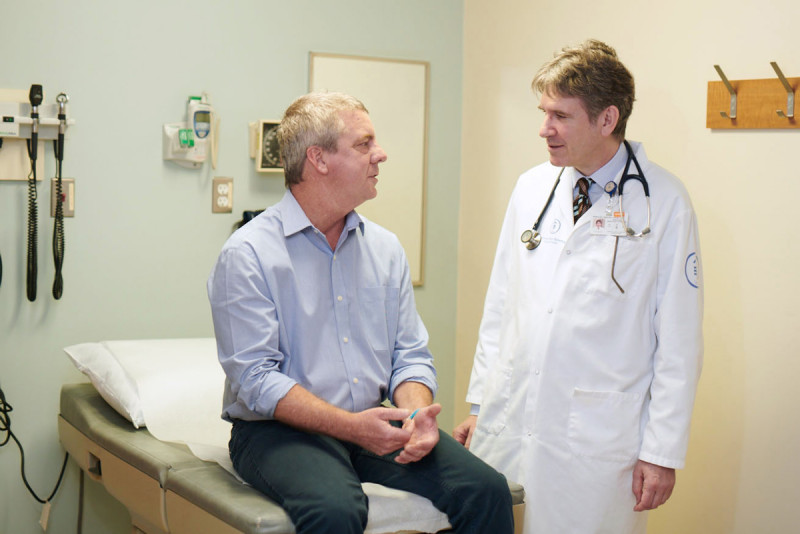
An allogeneic (A-loh-jeh-NAY-ik) transplant takes healthy blood or bone marrow stem cells from a donor and gives them to another person. After they’re transplanted, these cells go to the bone marrow and replace the person’s own stem cells. These transplanted cells then develop into all the parts of the blood and immune system. This includes red blood cells, white blood cells, and platelets.
The new cells can come from an adult donor or from donated umbilical cord blood. We may treat the new cells in the lab before we transplant them.
Before your transplant, you will have chemotherapy, or chemotherapy along with radiation therapy. It’s important to have this therapy before a transplant. It kills cancer cells and makes it harder for your immune system to reject the donor’s cells. It also makes some space in the bone marrow for the new donated stem cells.
Next, we add the new stem cells to your bloodstream through a tube or port. This procedure is like a blood transfusion and is called infusion.
Read our guide to allogeneic stem cell transplants. It helps you and your caregivers understand what to expect throughout your transplant journey.
If you need an allogeneic transplant, you and your doctor will talk about 2 important decisions:
- Who will be my donor?
- Will the donor cells need any treatment or changes before they’re infused?
How Are Patients and Donors Matched?
The process of finding a donor is a very important part of your transplant. Your donor may be an unrelated person, or a family member. Examples are a sibling, parent, or child related to you by blood.
All humans have genes that control how our immune system works. These genes are passed on to us from our parents. That’s why our siblings can have an identical pattern of immune genes.
Our immune genes are also shared by other humans. By chance, there may be an unrelated person who inherited the same immune genes as you. A sibling or an unrelated donor may be a “full match” for you. This means all their major immune genes are just like yours.
Not every person will have a matched sibling donor or a matched unrelated donor. Fortunately, transplant technology has improved a lot. Transplant results are similar, whether people had donors who were fully matched or were not fully matched.
Here are some examples of where mismatched donors come from:
- A related haploidentical donor. A haploidentical donor shares immune genes from your mother or your father, but not both. These family members can include a child, parent, sibling, niece or nephew, or cousin.
- An unrelated adult donor. The donor registry may have an unrelated fully matched donor. Or donors can have major immune genes that mostly match yours. These donors are called mismatched (partially matched) unrelated donors.
- A cord blood transplant. In a cord blood transplant, the stem cells come from the umbilical cord and placenta of a healthy newborn. The baby’s parents may have donated these cells to a public cord blood bank. Stem cells from babies can more easily adapt to a mismatched immune environment. You can learn more about MSK’s research on cord blood transplantation here.
We have more information about the donor search process below.
How Are Donated Cells Treated?
The cells collected from the donor are known as the graft. When we make no changes to the graft, it’s called an unmodified transplant or a conventional transplant.
Sometimes a lab must process the graft to change the cells before we give them to you. Changing the donor’s stem cells is called graft engineering.
There are a few ways the donor’s cells can be engineered before they’re transplanted:
- Stem cells collected from a donor also have the donor’s immune cells. We can remove these immune cells before the transplant if they’re likely to attack your body. This process is called T cell depletion. T cells are a type of white blood cell and are part of your immune system.
- We can engineer the donor’s cells to make them more likely to help you. We can balance different types of immune cells. We also can boost the number of helpful cells. Often, this engineering is done as part of a research study, also known as a clinical trial. Your doctor will talk with you about your options during the planning part of the transplant.
Some types of cancer are more likely to come back. You may get more treatments after your transplant, called donor lymphocyte infusions. With this therapy, your doctors slowly give you extra T cells from your donor. The low levels of T cells can stop the cancer. They also may help your immune system fight infections.
Finding a Donor
For most people, the first step in finding a donor is an immune system gene test. Immune system genes are called human leukocyte (LOO-koh-site) antigens (HLA). They’re markers on the surface of white blood cells. Gene typing the HLA takes about 5 to 7 days.
After your HLA typing test, your transplant doctor will talk with you about perhaps testing any of your siblings. Testing can tell us if they’re a match. For this test, your siblings would have either a blood test or a cheek swab. They do not have to come to MSK to get an HLA typing test.
Once we have your HLA typing, your transplant doctor can also search for unrelated donors. They will check donor registries to see if any unrelated volunteer donors also have your HLA profile.
You may not have a matched unrelated or sibling donor. If so, the next step is to search for potential donors who are mismatched (partially matched). During the unrelated donor search, we look for mismatched unrelated donors and cord blood stem cell products. Your doctor may ask you to reach out to other family members about them having HLA typing.
The National Marrow Donor Program has a list of possible stem cell donors. It’s also linked to other national and international registries. Together, there are almost 40 million potential donors.
Learn about donating bone marrow and blood stem cells.
MSK has a team of search coordinators who will help your doctor search for a donor. If you choose MSK as your transplant center, we will help look through all available options.
Searching for a donor often is a confusing process. MSK’s team will work through the donor selection process with you. Our goal is to make sure we consider all of your available donor options. We tailor our transplant approach to your personal needs.
For more information, please call our transplant service at 877-836-2268.
Harvesting the Donor’s Stem Cells
Bone marrow harvesting is a procedure that takes place before your transplant. Doctors will harvest (collect) stem cells that form blood. They collect them from your donor’s bone marrow or blood.
Bone Marrow Donation
Bone marrow is collected from harvest sites that have a lot of marrow. The front and back of the hips are common harvest sites. The breastbone has a lot of marrow, but we very rarely collect from there. The most common harvest site is the back of the hips.
Bone marrow is collected during an operation. During a bone marrow harvest, the donor has general anesthesia (medication to make you sleep). A doctor puts a hollow needle into the harvest site. There are no stitches. There may be some pain and tenderness at the harvest site for about a week.
Stem Cell Donation
We also collect stem cells from a donor’s circulating blood. These are called peripheral blood stem cells. They’re collected from the donor’s bloodstream using a procedure called apheresis (a-feh-REE-sis).
The first step is to raise the number of stem cells in the donor’s bloodstream. The donor will get injections (shots) of medication a few days before the procedure. This causes their body to make more stem cells than usual. The medication can cause flu-like symptoms and bone pain for a few days.
Apheresis does not need to be done in an operating room. The stem cells are easily collected while the donor is awake. The donor does not need general anesthesia (medication to make you sleep).
Apheresis takes place for several hours over 1 to 3 days. The donor’s blood comes out through a tube placed in their vein. It then goes through a machine that separates the stem cells from other blood cells. Those other blood cells are returned to the donor. The collected stem cells are either used right away or frozen and stored.



